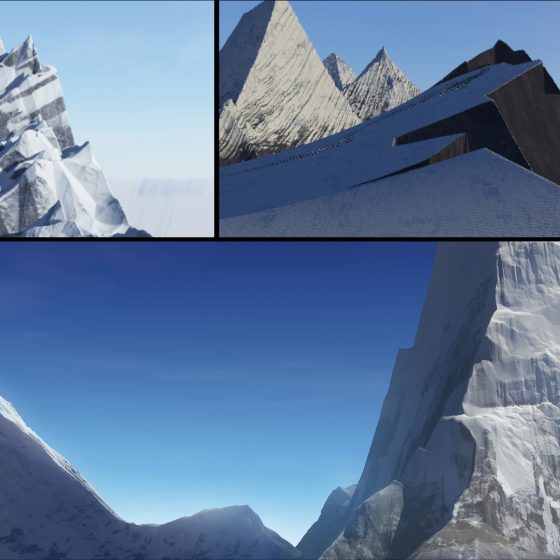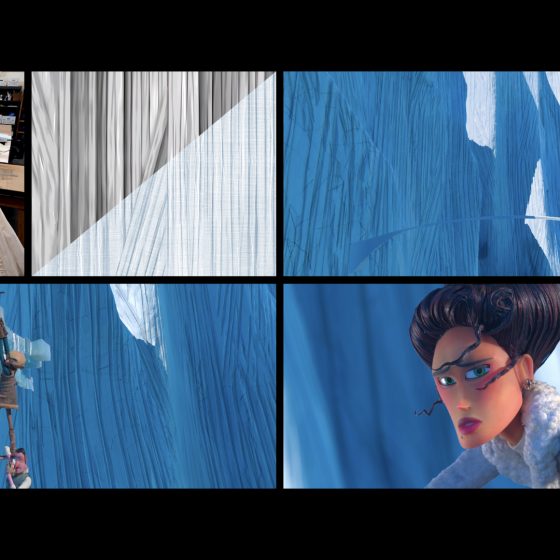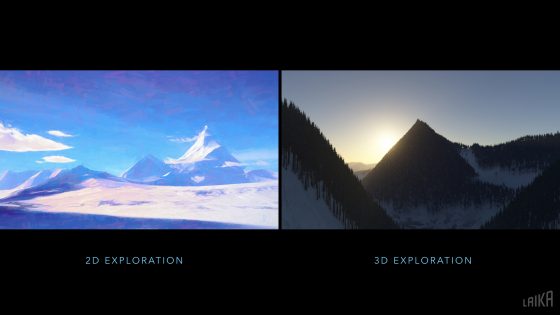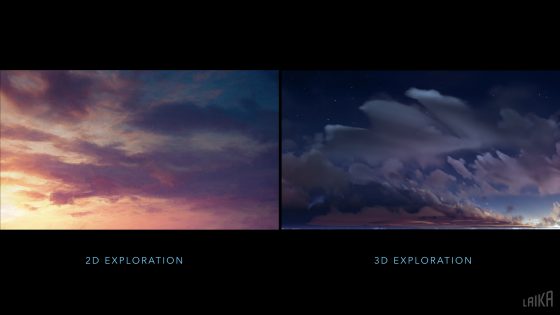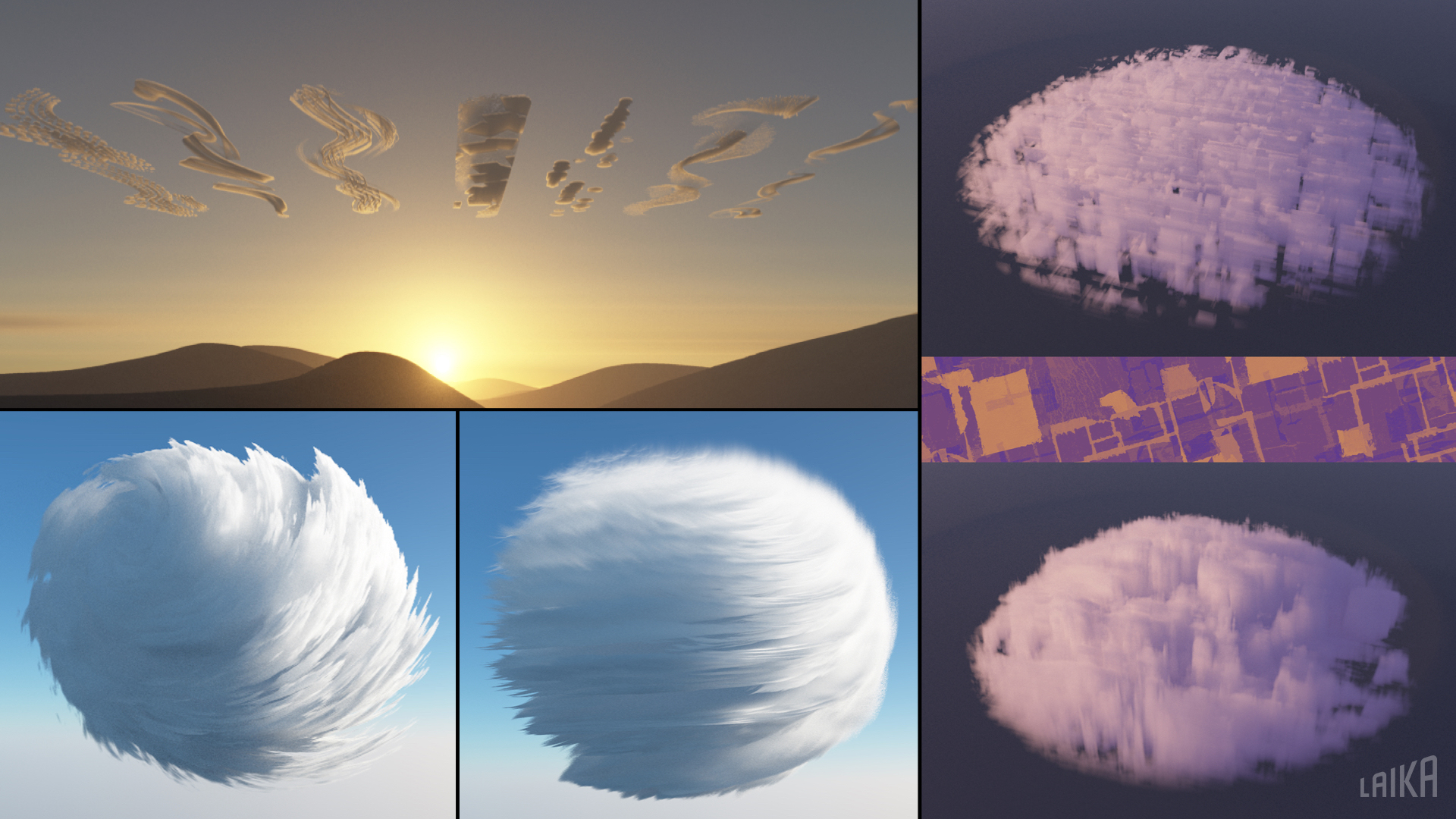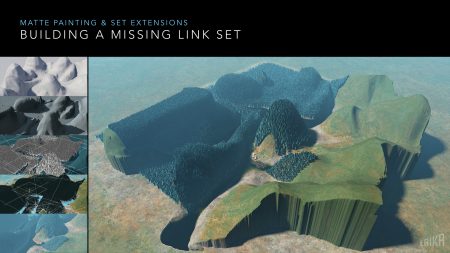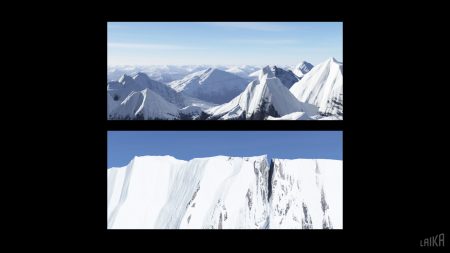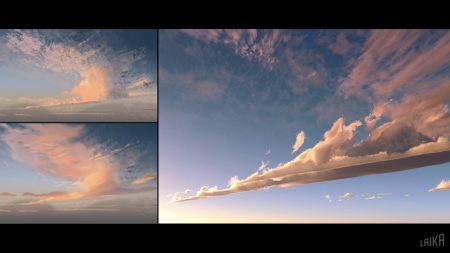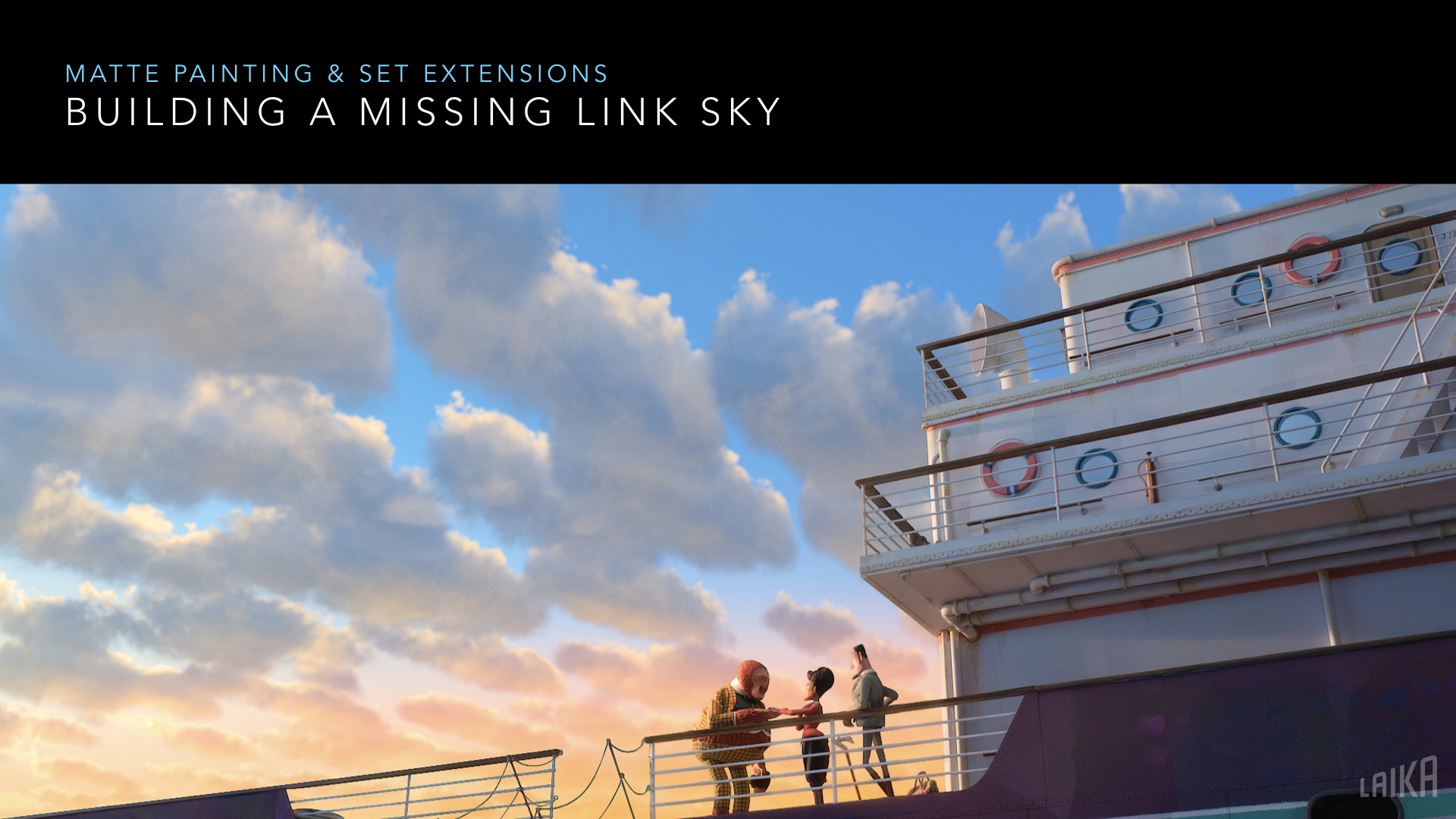In late 2016 we were contacted by LAIKA, one of the most successful stop motion-focused production companies, and makers of the critically acclaimed “Kubo and the Two Strings”, among many other excellent films. They were just beginning experimental use of Terragen on their next film and were exploring some new tools for their potential contributions to their workflow. We continued the dialog, working to support their production as much as possible, and a couple years later we got the opportunity to visit their studios for some in-person production support. We worked closely with Senior VFX Designer Joe Beckley who at that time was working toward finishing up what would become “Missing Link“, their latest Golden Globe Winning and Academy Award Nominated feature.
Now, with Joe and LAIKA’s help, we have the fantastic opportunity to share an in-depth look at how Terragen played a key role in that production! Read on for an interview with Joe, along with before-and-after images, shot breakdowns, and production tests. If you’ve ever wondered what it’s like to use Terragen in production, and how far you can push its output to match a highly stylized look, this should be an especially fascinating read.
Tell us a little about yourself. What is your background, how did you get into working in computer graphics? Where do you work now and what is your role there?
Like many artists in this field I always had a love for animation and filmmaking and knew it was something I wanted to do from a very early age. I grew up in a small town in Ohio and went on to study animation at the Columbus College of Art & Design in Columbus Ohio. Extensive coursework in sculpting, painting, drawing, and technical illustration were the cornerstone of my education and I’m forever grateful for that. CCAD was not only where I gained an unparalleled foundation in the fundamentals but I was introduced to so many established artists within the industry and made life long friends along the way.
After graduating from CCAD, I got job in the art department working on DisneyToon properties “Fox and the Hound II” and “Aristocats II”. I did everything from character design and background painting to color keys and style guides. It was a master class in production and I was able to get my feet wet with some amazing talent around me. I then made my way to DNA Productions in Dallas TX where we worked on the Jimmy Neutron TV series and “The Ant Bully”. I was hired to do some matte painting and 2D work but shortly after I was hired an opportunity within the lighting department opened up and I jumped on it. I did mostly shot lighting and some light compositing for the remainder of my time there. Once we wrapped on “The Ant Bully” I freelanced for a few studios doing everything from 3D lighting and texturing to matte painting painting and illustration before taking a job at LAIKA in Portland, OR in 2006.
When I first joined LAIKA the studio had three divisions. There was a Stop Motion division, CG feature division and a commercial division. I was hired as a Lighting Artist for LAIKA’s CG feature film division. The film in pre-production when I was hired went through several directors and production designers trying to find its voice but never ended up becoming a reality. I was then asked to be part of a very small creative collective where we were the bridge between development and production. We were a digital design group that would do everything from working with directors in development on helping them realize their visions to developing our own content all while infusing the latest technology and exploring less mainstream approaches to visuals. It was an artists dream to have that kind of freedom to explore and push boundaries. This group was ultimately the foundation of what is now the VFX department at LAIKA.
With the group being so small in the early days we were all wearing many hats and having a blast exploring and learning from one another. I started doing more and more texture work and took on any matte painting and set extension work that I could get my hands on. Over the years and through our now 5 production cycles I’ve done everything from shot lighting and texturing to matte painting and full 3D set extensions which leads me to where I am today. I am now the Senior VFX Designer where it’s my primary responsible to interpret ideas communicated by the director and other key creatives of a show into key art, production ready assets, environments, or matte paintings. My role is generally more creative in nature but I have a solid technical background and exert a strong practical hand in production as well.
What's a typical day like in your position? What do you find unique and exciting in your work?
The greatest part of my job is that on any given day I could be doing anything from concept art, 2D illustration/design, or building worlds/sets in 3D it just depends on the day. My work varies throughout the year and really depends on where we are in production on a particular film. If it’s early in production, I do a lot more 2D illustration and paint over concept work. When in full production I’m typically working closely with other key creatives throughout the studio helping to bring set extensions and skies to to life.
LAIKA is one of only a handful of places in the world that craft films like we do by joining the art of stop motion with computer generated imagery. Our approach alone is unique and extremely exciting. Blending those two worlds is one of the biggest challenges for the studio but also one that creates a true passion for the craft and pride for what we do. Since all of our sets and puppets are hand made and highly stylized I can’t just use a catalogue of real life photos or pre-made textures and shaders to texture our world. I also can’t just use traditional software and workflows out of the box. We’re shooting our sets with real cameras so in that way harnessing the power of a photorealistic renderer and shading techniques is key. The trick is manipulating the software to mimic the style and material creation to the way they are being built and shot practically on our stages. All the clouds, skies and extensions that are created need to have the physical properties of real clouds, skies, and locations but they must also have the style and appear to be built from the same materials of the practical sets.
What used to take several departments and teams several weeks to accomplish I was able to orchestrate in a matter of days…
What is your experience with Terragen? When did you start using it? What made you choose it for your workflow and how does it benefit your work? What do you like most about it?
I only started using Terragen a hand full of years ago. When we were finishing up “Kubo and the Two Strings” and starting to look toward our next film “Missing Link” that’s when I saw the sheer amount of work ahead I began to explore different avenues than what I’ve typically delivered on previous films. That’s when I came across Terragen and loved what I was seeing from studios and films that were using the software. Once I started playing with it I quickly learned just how artist friendly it is. There was certainly a learning curve, as there is with any software, but once I got over the first few hurdles and hiccups it was off and running.
There were 65 unique locations and 465 set extensions that I had a very large part in helping to create. From very early on in the show I knew I was going to have to approach this film totally different than our previous films. Through the early development stages with the Production Designer, Nelson Lowry and Director Chris Butler. I was able to take concept art, quickly mock up sequence locations or establishing shots in just a few days. By spending just a few days prepping a sequence landscape by getting all the shot cameras for a sequence imported to Terragen, I could mock up a rough set based on concept art and block in rough lighting and atmosphere. This would usually be simple shapes defining various parts of the terrain and rough objects scattered to show trees, plants, or other assets that were pertinent to the sequence. It was a very broad strokes pass that we could see and sculpt from nearly every camera in the sequence. Then I would have Nelson desk side and we could effortlessly art direct shots together to get the ideal layout for every shot.
I loved that in very little time a rough time of day lighting scenario would allow us to see, almost interactively, the skies and sets through shot cameras. Once the rough terrain was bought off by Nelson and Chris, I would dive in to creating and sculpting final structures, fully develop the shader networks, work with our modelers on props and other various items that would be populated and hone in the lighting and atmosphere. What used to take several departments and teams several weeks to accomplish I was able to orchestrate in a matter of days and get to our ultimate goal of a sequence-ready set prepped for production much more efficiently.
What other software do you use?
The main suite of software that I use besides Terragen is Maya, Houdini, Photoshop, Mari, and Substance Painter. I will occasionally use SpeedTree for tree and plant assets but for the most part our assets were so specific and stylized that our CG modelers could custom model a lot of our vegetation and set dressing elements quicker and more on style.
Where do you get your inspiration? Any favorite artists, films, etc?
There are so many great sources of inspiration these days it’s hard to pick just a few. I love artists, films and studios that think outside the box both in storytelling and visuals and I find myself drawn toward and inspired by a lot of traditional artists, illustrators, and painters both new to the scene and veterans alike. Two of the more recent examples of studios exploring visually is what Sony did with “Into the Spiderverse” for CG animation and what “Klaus” is doing for traditional animation. Both are examples of studios pushing the boundaries of what we routinely see in feature animation these days, much like LAIKA has done and continues to do. With more and more streaming services available animation is seeing a whole new world open up and studios otherwise too small or remote now have platforms to show their projects and it’s really exciting to see all the diversity in story and visuals.
Do you have any advice to share for other artists and people who might be interested in doing similar work?
Don’t be afraid to push the boundaries, experiment with new ideas and strive for quality rather than quantity. It’s all in the details. Learn from the ones who inspire you and don’t be afraid of creating your own visual voice.
While Terragen is used on a huge variety of incredible film productions, it’s rare that we get to see behind the curtain, much less share that with our other customers. So we are thrilled and grateful that Joe Beckley and LAIKA were willing to do this interview and to let us share the many images that are included. Be sure to read part 2 of this interview where we take a closer look at some of Joe’s favorite environments from Missing Link and how they were built, combining physical sets and Terragen renders.
Missing Link does an amazing job of blending CGI and practical content, making it well worth its Golden Globe win for Best Animated Feature and its subsequent 2019 Oscar nomination. Laika continues to push the envelope and we are so excited that Terragen is a part of their toolbox!
Read More: Skies and Set Extensions
Click above to find out more about how Joe created some of his favorite Missing Link environments with Terragen
All imagery was generously provided by Laika, LLC and Joe Beckley and remains copyright of its respective owners.







